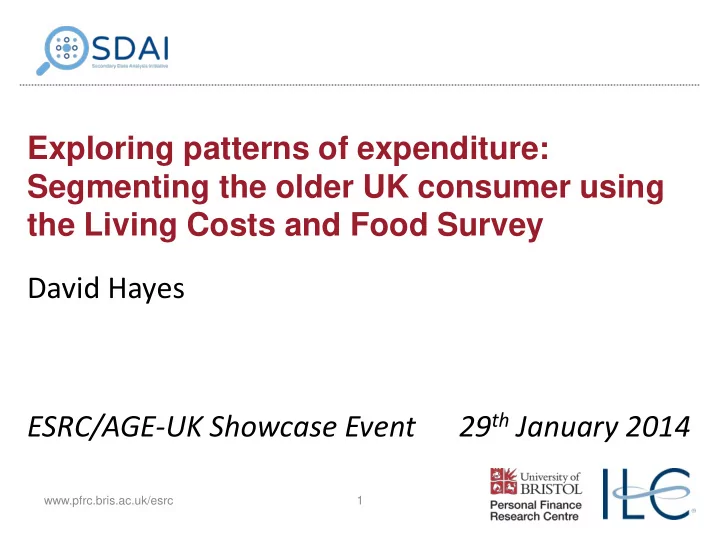

Exploring patterns of expenditure: Segmenting the older UK consumer using the Living Costs and Food Survey David Hayes 29 th January 2014 ESRC/AGE-UK Showcase Event www.pfrc.bris.ac.uk/esrc 1
Our Approach • Using the Living Costs and Food (LCF) Survey, we: 1. Describe average household expenditure by age (using descriptive analysis); 2. Segment older households based on their patterns of expenditure (using cluster analysis); 3. Explore cluster membership (using descriptive and CHAID analysis). www.pfrc.bris.ac.uk/esrc 2
Standard LCF expenditure categories • Housing, fuel & power • Alcohol & tobacco • Recreation & culture • Clothing & footwear • Communication • Restaurants & hotels • Transport • Education • Miscellaneous goods & • Food & non-alc. drinks services • Health • Household goods & services www.pfrc.bris.ac.uk/esrc 3
Data Considerations • Good sample of household heads aged 50+ • To cover transition into and beyond retirement • Total sample size of 2,769 • Good distribution of age groups (even 80+ ~ 12%) • Equivalised expenditure • To take account of household size www.pfrc.bris.ac.uk/esrc 4
Absolute and equivalised expenditure by age 600 510 500 Pounds per week (£) 400 300 Absolute 286 Equivalised 189 200 160 100 0 50 but under 55 55 but under 60 60 but under 65 65 but under 70 70 but under 75 75 but under 80 80 and above yrs yrs yrs yrs yrs yrs www.pfrc.bris.ac.uk/esrc 5
Proportion of total expenditure by age ↑ Food & non-alc. drink increases: 12% to 19% ↑ Housing, fuel & power doubles: 12% to 24% ↔ Communication constant: 3% ↓ Clothing & footwear halves: 6% to 3% ↓ Transport decreases: 18% to 7% ↓ Recreation drops: 16% to 11% www.pfrc.bris.ac.uk/esrc 6
The segmentation (clustering) process • Exploring how types of expenditure co-vary • Identifies dominant patterns • Classifies people into segments based on these • Clustered on the 12 expenditure categories • ...the optimal solution contained six clusters www.pfrc.bris.ac.uk/esrc 7
Drivers of cluster membership • Highly statistically significant variations in expenditure for all 12 categories • Three categories were particularly strong • Alcohol and tobacco • Clothing and footwear • Housing, fuel and power www.pfrc.bris.ac.uk/esrc 8
The clusters Percentage in cluster (%) Mean weekly expenditure ‘Conservative consumers’ 46 138 ‘Foodies’ 19 228 ‘Burdened by bills’ 11 231 ‘Smokers’ 9 245 ‘Recreation and clothing’ 4 392 ‘Socialites’ 12 405 The average equivalised expenditure across the sample is £217. www.pfrc.bris.ac.uk/esrc 9
Spend far below average on non-essentials (such as recreation and hotels) Conservative Consumers • Spent £138 on average • Transport (£18) much lower than average (£32) • Only 47% connected to the internet • More likely to be the oldest old (22% cf. 15%) • 38% in the lowest income quartile; 60% retired • 56% gave benefits as main source of income www.pfrc.bris.ac.uk/esrc 10
Very high expenditure on food (£58 compared to the average of £34) Foodies • Spent £228 on average • Close to average expenditure in most categories • A half (54%) live in two-adult households • Very few households are renting (12%, cf.25%) • Only 18% in lowest income quartile • Larger houses (58% cf. 50% with 6+ rooms) www.pfrc.bris.ac.uk/esrc 11
Very high proportion of expenditure on housing costs (£4 in every £10, twice the average) Burdened by Bills • Spent £231 on average • All other expenditure is relatively low • Low transport costs (lowest petrol expenditure) • 70% in rented accommodation (cf. 24%) • Including 45% from a social landlord • More single households www.pfrc.bris.ac.uk/esrc 12
Spent £28 a week on tobacco products Smokers • Spent £245 on average • Very high spend on alcohol and tobacco (£36 per week/15% of total expenditure, cf. 3%) • One of the ‘younger’ clusters (62% under 65) • Almost a third still in full-time employment • Home-ownership is relatively low (42% cf. 54%) www.pfrc.bris.ac.uk/esrc 13
At £65 each week, these fashionistas spend more on clothing than all the other groups combined! Recreation and Clothing • One of the two high-spending clusters (£392) • High spend on recreation (£65) & transport (£53) • Only 21 per cent of this cluster are 70 and above • Two-thirds in larger houses (6+ rooms) • 20% say benefits main income (cf. 10% socialites) • Half of the cluster in the highest income quartile www.pfrc.bris.ac.uk/esrc 14
Enjoy the finer things in life, spending £131 per week on eating out, holidays and recreation The Socialites • One of the two high-spending clusters (£405) • Spent £96 on transport costs (24% cf.15%) • Three quarters under 65; 41% working full time • Income – 57% earnings; 33% investments • More than half in highest income quartile • 90% of households connected to the internet www.pfrc.bris.ac.uk/esrc 15
Important socio-demographic characteristics • Tenure: 97% of Socialites were homeowners • Compared with 29% of Burdened by Bills • Age: 40% of Smokers aged under 60 • Compared with just 26% of Conservative Consumers • Income: 7% of R&C in lowest income quartile • Compared with 39% of Burdened by Bills www.pfrc.bris.ac.uk/esrc 16
Policy implications • Expenditure poverty not atypical • Housing costs key in wellbeing • Smokers are young (stop/morbidity) • No such thing as the ‘older consumer?’ • Depends on preferences/constraints, resources, mobility www.pfrc.bris.ac.uk/esrc 17
What else would help inform policy? • Conservative Consumers are a diverse group • Positive/negative constraints? • Hostels, boarding houses, and institutions such as rest/care and nursing homes are excluded • The true effect of ageing vs. generational effects remains unclear – further analysis needed www.pfrc.bris.ac.uk/esrc 18
Questions and further discussion • http://www.bris.ac.uk/geography/research/pfrc/esrc/ • david.hayes@bristol.ac.uk • @PFRC_David www.pfrc.bris.ac.uk/esrc 19
Recommend
More recommend